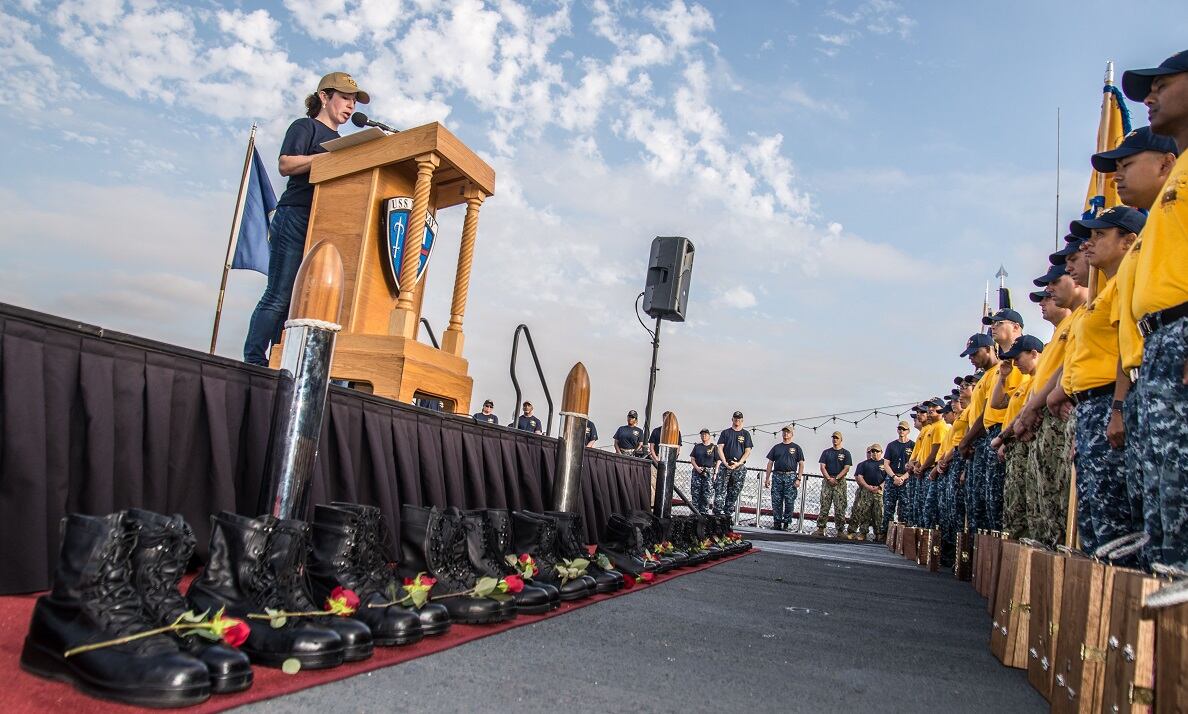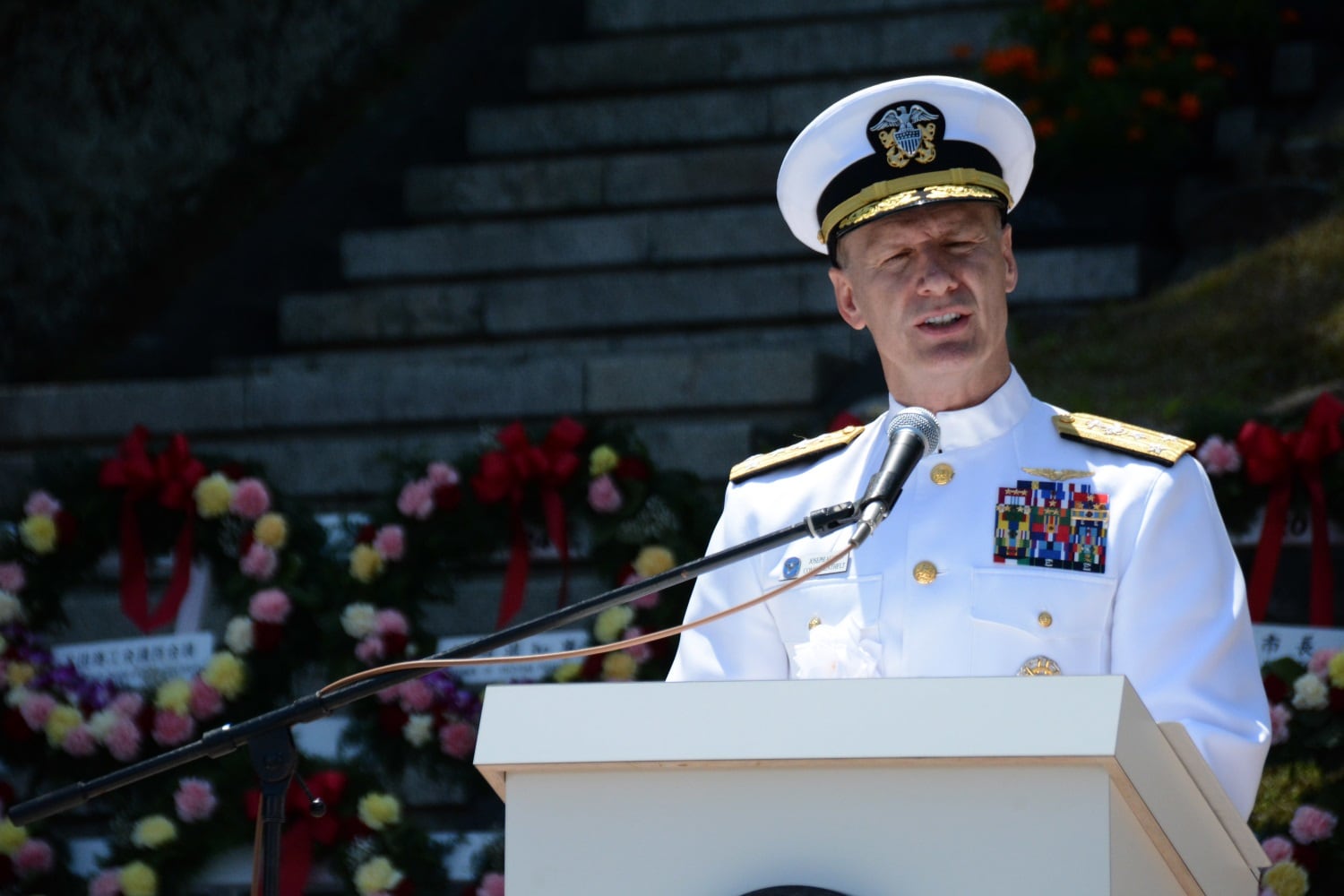The former head of the Japan-based 7th Fleet who was fired in the wake of two fatal destroyer collisions in the west Pacific last summer is for the first time offering his take on what led to the disasters, while at times questioning Big Navy’s account of what transpired.
Retired Vice Adm. Joseph Aucoin was fired as 7th Fleet commander on Aug. 23, just a few days after the destroyer John S. McCain collided with a tanker near Singapore, an incident that killed 10 crew members.
A few months before that, seven other sailors died aboard the warship Fitzgerald when it was struck by a merchant vessel off Japan in June.
Since then, Navy leadership has decried a lack of readiness, maintenance and training among ships based out of Japan, and across the surface fleet in general.
Writing in the Naval Institute’s “Proceedings” magazine this month, Aucoin takes issue with how Navy leadership characterized the shortcomings in a comprehensive review and strategic readiness review done in the wake of the disasters.
“The Comprehensive Review (CR), Strategic Review (SR), and some media reporting could lead one to the impression my staff and I were oblivious to or unconcerned about the manning, training, and maintenance deficiencies affecting my ships and their ability to carry out their assigned missions,” Aucoin writes. “That was not the case.”
RELATED

Instead, Aucoin alleges that his bosses at U.S. Pacific Fleet knew about the negative impacts that increased 7th Fleet operational tempo was having on training and maintenance “well prior” to the collisions.
“Despite these explicitly stated concerns, the direction we received was to execute the mission,” he writes.
Aucoin also questioned the narrative that the surface fleet’s shortcomings were limited to Japan.
A San Diego-based cruiser, Lake Champlain, was involved in a daytime collision with a Korean vessel last spring, he writes, suggesting a problem that was not limited to 7th Fleet.
Japan-based ships began getting the short end of the stick in 2014, when manning levels for those warships fell because of Navy policies that prioritized stateside ships, according to Aucoin.
He writes that his staff convened a Forward-Deployed Naval Force manning summit in June, and he takes issue with this effort not being mentioned in the comprehensive review, which was overseen by Fleet Forces Command head Adm. Phil Davidson.
“While it is said that the (comprehensive review) focused primarily on training and readiness, it did not address manpower issues nearly enough,” Aucoin writes. “I do not know how one can exclude manpower in a discussion on readiness in a high-operational tempo (OpTempo) environment.”
Aucoin also writes that the realities of west Pacific command and control were neglected in the reviews.
Afloat Training Group West Pacific, responsible for training and certification of Japan-based ships, reported to Naval Surface Force Pacific and not 7th Fleet, he writes.
RELATED

The “Third Fleet Forward” initiative, which sends stateside ships to 7th Fleet waters to relieve the pressure on 7th Fleet ships, came to entail those stateside ships operating outside 7th Fleet’s command and taking on missions that didn’t ease the workload of 7th Fleet cruisers or destroyers, according to Aucoin.
Aucoin also wonders why he was not interviewed for the comprehensive review.
“How comprehensive is the CR when neither Commander, Naval Surface Forces (CNSF), nor I, as the numbered fleet commander, was interviewed or asked for inputs?” he writes. “For the sake of our Navy, a transparent examination of the problem should include a full understanding of the challenges with which we were faced.”
Naval operations “expanded dramatically” in the Indo-Asia Pacific since 2015, Aucoin writes, and demands from Pacific Fleet and U.S. Pacific Command increased, and readiness declined as a result.
“This was known both to commanders in FDNF and across the Navy,” Aucoin writes. “Through 2016 and early 2017, my staff produced detailed data quantifying the increase in (cruiser and destroyer) operational tasking and demonstrating the consequent decline in executed maintenance and training, which I sent directly to (Pacific Fleet).”
Pacific Fleet agreed that 7th Fleet’s maintenance and training were in trouble, he writes, “yet (7th Fleet) received no substantive relief from tasking or additional resources.”
Pacific Fleet spokesman Capt. Charles Brown said several investigations into what led up the collisions had been undertaken inside and outside the Navy.
“We do not have anything to add to these numerous reviews and investigations,” he said in an email.
Aucoin writes that his command worked to stay focused on executing operations safely and pushing back when they could not fulfill a request from higher up.
“In a few cases, we were able to argue for changes that allowed ships to complete training or maintenance,” he writes. “In many other cases, our arguments and recommendations were either overruled or ignored.”
Chief of Naval Operations Adm. John Richardson has said repeatedly since the collisions that commanders need to be able to say no to requests from higher up when their ships are not mission-ready.
The Navy needs to push back when combatant commands ask too much, Aucoin writes.
“It would have been reassuring if the (comprehensive review) had addressed the Navy’s organizational responsibility to act as a check against such increasing demand when divorced from the reality of readiness impacts,” he writes. “While the situation was well known by more senior leaders, this demand went unfiltered and fell to me.”

“I do not understand why our leaders do not push back on the excessive demand on our ships or exhibit more transparency on the true extent of the issues the Navy faces beyond Seventh Fleet,” Aucoin writes.
As 49 sailors had to be cross-decked in Japan to fill gaps on the ships, and five of 11 quartermaster billets were gapped, Aucoin writes that it was “frustrating” to hear of San Diego ships that were so over-manned they had to leave 30 sailors on the pier.
“In addition to a soaring OpTempo, the cumulative effect over time of not having enough people and resorting to cross-decking had a debilitating effect on readiness,” he writes. “We not only lacked overall numbers of people, we also lacked mentors, the men and women with the skills and experience that are vital to raising our next generation of experienced sailors.”
While taking Big Navy to task, Aucoin also points out his own faults near the article’s end.
“While we were able to turn off some taskings, in hindsight, I should have reiterated a ‘no’ when issued ‘force to source orders’ for operational tasking,” he writes. “I accept this mistake. At the same time, in the future I hope our Navy will listen more carefully to our commanders on the scene.”
Seventh Fleet is a hard assignment to fill, due to the rigors of overseas screening and the affects on families, he writes.
“My foremost hope is that my Navy can better support the men and women of the FDNF,” he writes. “Most sailors in FDNF find the mission exhilarating. At the same time, these wonderful people do need reasonable and consistent support for their ships, their families, and their careers.”
Geoff is the managing editor of Military Times, but he still loves writing stories. He covered Iraq and Afghanistan extensively and was a reporter at the Chicago Tribune. He welcomes any and all kinds of tips at geoffz@militarytimes.com.





